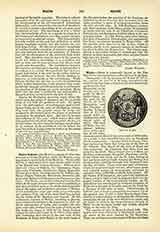

Magnesia, a titular see in Lydia, suffragan of Ephesus, lying about 40 miles northeast of Smyrna and supposed to have been founded by the Magneti of Thessaly in the fifth century p. c. Lucius Scipio defeated Antiochus, King of Syria, there in 190 B.C. It was ruined by an earthquake in the reign of Tiberius, but recovered and prospered. It is now known as Manisa, a flourishing town of 35,000 inhabitants in the sanjak of Sarakhan, containing twenty mosques, and a Greek and an Armenian church. The following bishops are known: Eusebius, at Ephesus (431); Alexander, at Chalcedon (553); Stephen at Constantinople (680); Basil at Nicaea (787); Athanasius at Constantinople (869); Luke at the synod held there in 879.
There was another see in Asia called Magnesia ad Maeandrum, which was situated on the Meander in Ionia. Said to have been built by Leucippus, it was the site of the celebrated temple of Diana Leucophryne, erected by Hermogenes, which was granted the privilege of asylum by Scipio, on account of the fidelity of the inhabitants. Eight of its bishops are known: Damasus (second century); Eusebius at Philoppolis (343); Macarius, contemporary of St. Chrysostom; Daphnus at Ephesus (431); Leontius at the Robber-Council (449); Patritius at the synod in Trullo (692); Basil at Nicaea (787); Theophilus at Constantinople (879); Basil and Eusebius may be those referred to in speaking of the Lydian Magnesia.
A. A. MACERLEAN

